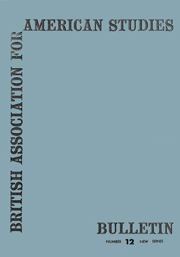No CrossRef data available.
Article contents
“For the Good of the Association”: American Trade Unionism At the Grass Roots
Published online by Cambridge University Press: 17 February 2011
Extract
“If it weren't for the door prize they wouldn't come at all,” confided the president of the local. The doorkeeper stood with his bowl of dimes, religiously unlocking and relocking the door as each member presented himself for admittance, reaching at the sane time into his trousers' pocket for his ten cents contribution to the evening's sweepstake. Outside, the temperature was ten degrees below freezing; inside, the gas heater on the ceiling buzzed noisily. One by one, the members flopped into the vacant chairs, unzipped their padded jackets, and smoked and chewed and chatted happily. The room was pleasantly warm, the chairs uncomfortably hard, and the walls had the timeless dinginess of dark green paint. On a dais at one end, between the narrow trestle table covered with files, dues books, and loose papers sat the four officers of the local. To one side, leaning precariously in a wobbly standard-holder, was the Flag. From the wall behind the dais, past presidents of the International and the State Federation of Labor looked down on the meeting. Between them was the charter of the local; around the other walls, in varying degrees of ornateness, were the framed charters of different locals in the town which also used the Labor Temple. A painted piano in one corner, a refrigerator and a row of coat hangers completed the furnishings. Smiling broadly, the president rose and banged his gavel on the table gently. The hubbub subsided rapidly as he began reading the historic formula for opening, the meeting.
- Type
- Research Article
- Information
- Copyright
- Copyright © British Association for American Studies 1959
References
page 3 note 2 Details of the survey are given in the Appendix at the end.
page 3 note 3 The chief officers of the local were the president, vice-president, recording secretary, financial secretary, and treasurer. There were also three trustees, a conductor, and a sentinel. All were elected annually by the membership. The bargaining committee and grievance committee (of which the vice-president – later elected president – was the chairman) met as and when required. They were elected on a departmental basis, and were to all intents and purposes identical, being composed of the officers and shopstewards. A business representative (or “business agent”) was present at nost meetings of the local. He was a full-time, paid official of the union, elected by all the locals in the District. His advice was frequently sought by the local officers, and he was the chief negotiator with the company on all matters affecting the contract and handled the more intractable grievances.
page 5 note 1 See Appendix.


